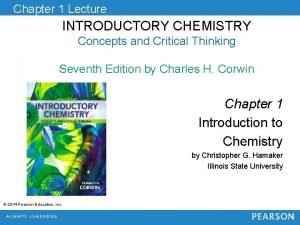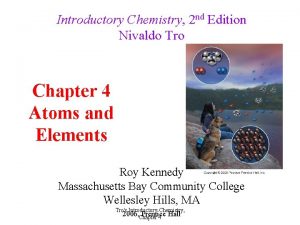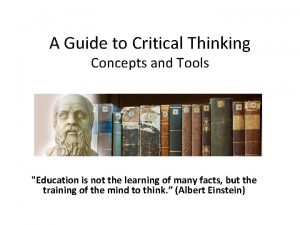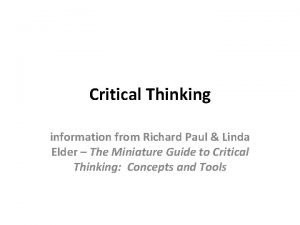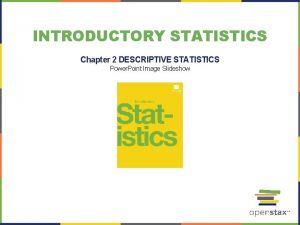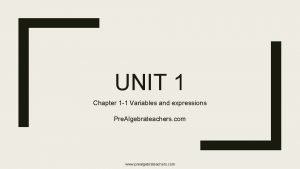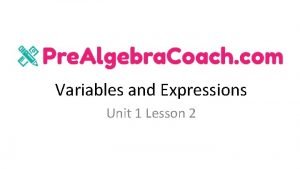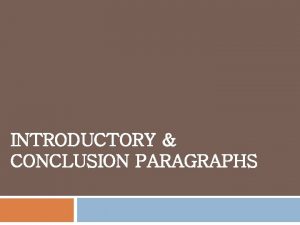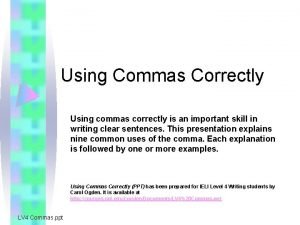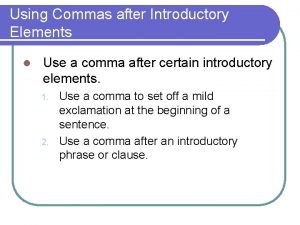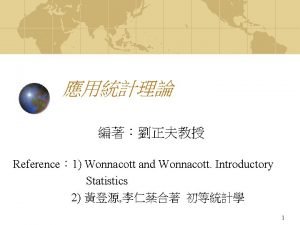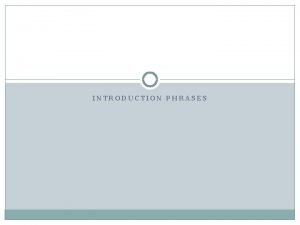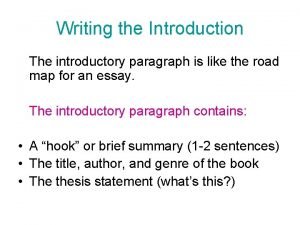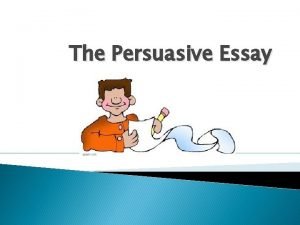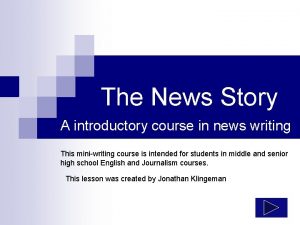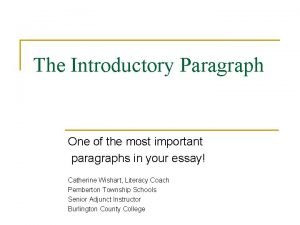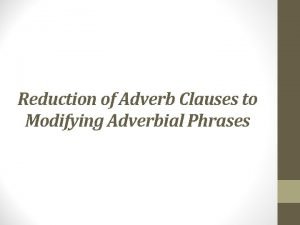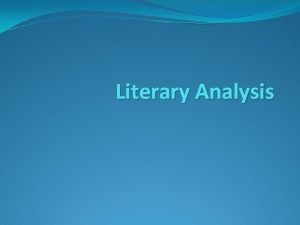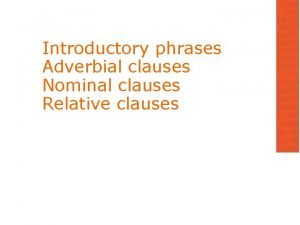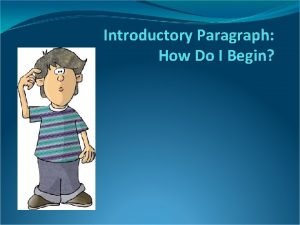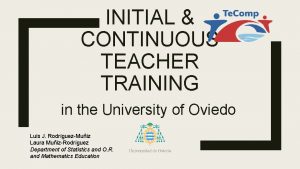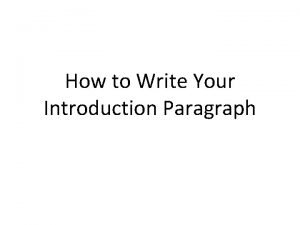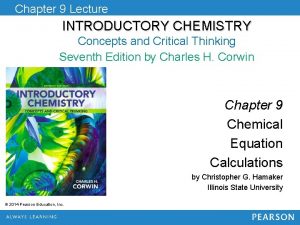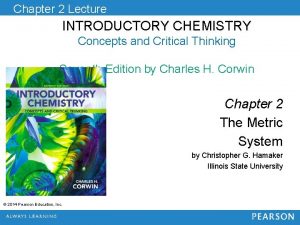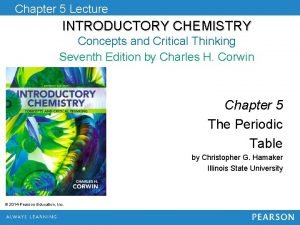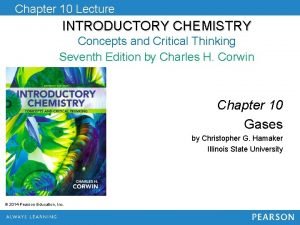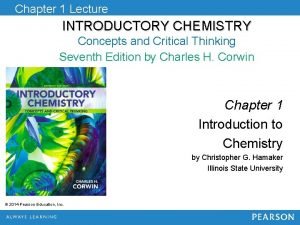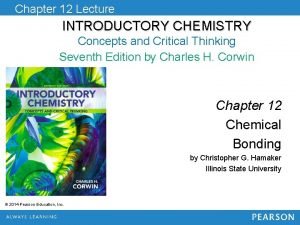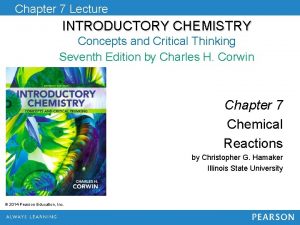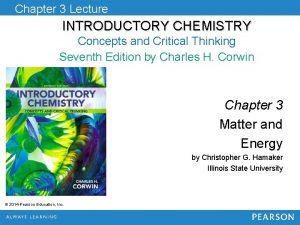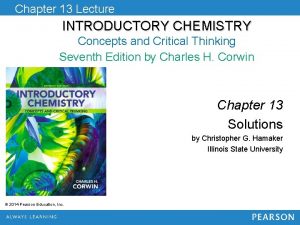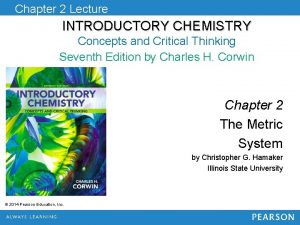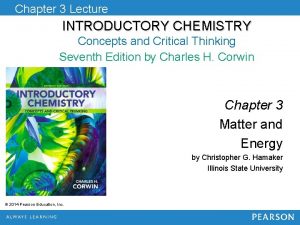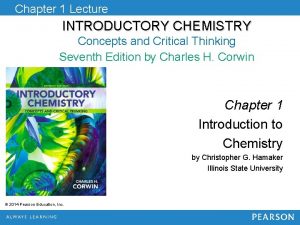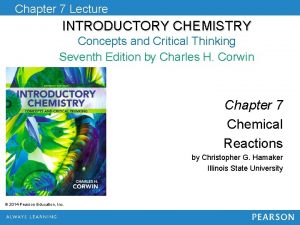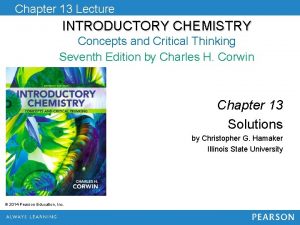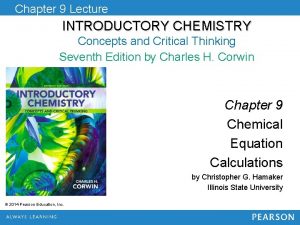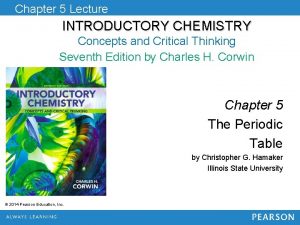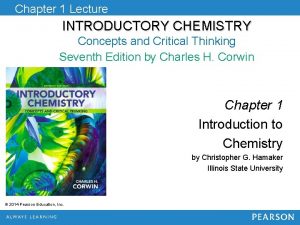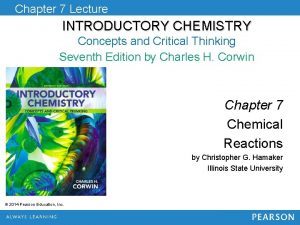Chapter 1 Lecture INTRODUCTORY CHEMISTRY Concepts and Critical



































- Slides: 35

Chapter 1 Lecture INTRODUCTORY CHEMISTRY Concepts and Critical Thinking Seventh Edition by Charles H. Corwin Chapter 1 Introduction to Chemistry by Christopher G. Hamaker Illinois State University © 2014 Pearson Education, Inc.

Evolution of Chemistry • The Greeks believed in four basic elements: 1. Air 2. Fire 3. Water 4. Earth • All substances were combinations of these four basic elements. © 2014 Pearson Education, Inc. Chapter 1

© 2014 Pearson Education, Inc. Chapter 1

The Scientific Method • Science is the methodical exploration of nature followed by a logical explanation of the observations. • An experiment involves scientists who explore nature according to a planned strategy and make observations under controlled conditions. © 2014 Pearson Education, Inc. Chapter 1

The Scientific Method, Continued • The scientific method is a systematic investigation of nature and requires proposing an explanation for the results of an experiment in the form of a general principle. • The initial, tentative proposal of a scientific principle is called a hypothesis. • After further investigation, the original hypothesis may be rejected, revised, or elevated to the status of a scientific principle. © 2014 Pearson Education, Inc. Chapter 1

Applying the Scientific Method Step 1: Perform a planned experiment, make observations, and record data. Step 2: Analyze the data and propose a tentative hypothesis to explain the experimental observations. Step 3: Conduct additional experiments to test the hypothesis. If the evidence supports the initial proposal, the hypothesis may become a scientific theory. © 2014 Pearson Education, Inc. Chapter 1

Applying the Scientific Method, Continued • After sufficient evidence, a hypothesis becomes a scientific theory. • A natural law states a measurable relationship. © 2014 Pearson Education, Inc. Chapter 1

Chapter Summary • Scientists use the scientific method to investigate the world around them. • Experiments lead to a hypothesis, which may lead to a scientific theory or a natural law. • Chemistry is a central science with many branches. • The impact of chemistry is felt in many aspects of our daily lives. © 2014 Pearson Education, Inc. Chapter 1

Prerequisite Science Skills by Christopher G. Hamaker Illinois State University © 2014 Pearson Education, Inc. Chapter 1

Measurements • A measurement is a number with a unit attached. • Every measurement has a degree of inexactness, termed uncertainty. • We will generally use metric system units. These include: – The centimeter, cm, for length measurements – The gram, g, for mass measurements – The milliliter, m. L, for volume measurements © 2014 Pearson Education, Inc. Chapter 1

Length Measurements • Let’s measure the length of a candy cane. • Ruler A has 1 -cm divisions, so we can estimate the length to ± 0. 1 cm. The length is 4. 2 ± 0. 1 cm. • Ruler B has 0. 1 -cm divisions, so we can estimate the length to ± 0. 05 cm. The length is 4. 25 ± 0. 05 cm. © 2014 Pearson Education, Inc. Chapter 1

Uncertainty in Length • Ruler A: 4. 2 ± 0. 1 cm; Ruler B: 4. 25 ± 0. 05 cm. • Ruler A has more uncertainty than Ruler B. • Ruler B gives a more precise measurement. © 2014 Pearson Education, Inc. Chapter 1

Mass Measurements • The mass of an object is a measure of the amount of matter it affected. • Mass is measured with a balance and is not affected by gravity. • Mass and weight are not interchangeable. © 2014 Pearson Education, Inc. Chapter 1

Volume Measurements • Volume is the amount of space occupied by a solid, a liquid, or a gas. • There are several instruments for measuring volume, including: – Graduated cylinder – Syringe – Buret – Pipet – Volumetric flask © 2014 Pearson Education, Inc. Chapter 1

Significant Digits • Each number in a properly recorded measurement is a significant digit (or significant figure). • Significant digits express the uncertainty in the measurement. • When you count significant digits, start counting with the first nonzero number. • Let’s look at a reaction measured by three stopwatches. © 2014 Pearson Education, Inc. Chapter 1

Significant Digits, Continued • Stopwatch A is calibrated to seconds (0 s); Stopwatch B to tenths of a second (0. 0 s); and Stopwatch C to hundredths of a second (0. 00 s). • Stopwatch A reads 35 s; B reads 35. 1 s; and C reads 35. 08 s. – 35 s has two significant figures. – 35. 1 s has three significant figures. – 35. 08 has four significant figures. © 2014 Pearson Education, Inc. Chapter 1

Significant Digits and Placeholders • If a number is less than 1, a placeholder zero is never significant. • Therefore, 0. 5 cm, 0. 05 cm, and 0. 005 cm all have one significant digit. • If a number is greater than 1, a placeholder zero is usually not significant. • Therefore, 50 cm, 500 cm, and 5000 cm all have one significant digit. © 2014 Pearson Education, Inc. Chapter 1

Exact Numbers • When we count something, it is an exact number. • Significant digit rules do not apply to exact numbers. • An example of an exact There are 7 quarters on this slide. © 2014 Pearson Education, Inc. Chapter 1 number:

Rounding Off Nonsignificant Digits • All numbers from a measurement are significant. However, we often generate nonsignificant digits when performing calculations. • We get rid of nonsignificant digits by rounding off numbers. • There are three rules for rounding off numbers. © 2014 Pearson Education, Inc. Chapter 1

Rules for Rounding Numbers 1. If the first nonsignificant digit is less than 5, drop all nonsignificant digits. 2. If the first nonsignificant digit is greater than or equal to 5, increase the last significant digit by 1 and drop all nonsignificant digits. 3. If a calculation has several multiplication or division operations, retain nonsignificant digits in your calculator until the last operation. © 2014 Pearson Education, Inc. Chapter 1

Rounding Examples • A calculator displays 15. 73849 and 3 significant digits are justified. • The first nonsignificant digit is a 3, so we drop all nonsignificant digits and get 15. 7 as the answer. • A calculator displays 18. 750019 and 3 significant digits are justified. • The first nonsignificant digit is a 5, so the last significant digit is increased by one to 8. All the nonsignificant digits are dropped, and we get 18. 8 as the answer. © 2014 Pearson Education, Inc. Chapter 1

Rounding Off and Placeholder Zeros • Round the measurement 183 m. L to two significant digits. – If we keep two digits, we have 18 m. L, which is only about 10% of the original measurement. – Therefore, we must use a placeholder zero: 180 m. L. • Recall that placeholder zeros are not significant. • Round the measurement 48, 457 g to two significant digits. – We get 48, 000 g. • Remember, the placeholder zeros are not significant, and 48 grams is significantly less than 48, 000 grams. © 2014 Pearson Education, Inc. Chapter 1

Adding and Subtracting Measurements When adding or subtracting measurements, the answer is limited by the value with the most uncertainty. Let’s add three mass measurements. The measurement 114. 3 g has the greatest 114. 3 g uncertainty (± 0. 1 g). 0. 75 g The correct answer is 116. 6 g + 0. 58 g 1 115. 63 g 1 © 2014 Pearson Education, Inc. Chapter 1

Multiplying and Dividing Measurements • When multiplying or dividing measurements, the answer is limited by the value with the fewest significant figures. • Let’s multiply two length measurements: (7. 28 cm)(4. 6 cm) = 33. 488 cm 2 • The measurement 4. 6 cm has the fewest significant digits—two. • The correct answer is 33 cm 2. © 2014 Pearson Education, Inc. Chapter 1

Exponential Numbers • Exponents are used to indicate that a number has been multiplied by itself. • Exponents are written using a superscript; thus, (4)(4)(4) = 43. • The number 3 is an exponent and indicates that the number 4 is multiplied by itself three times. It is read “ 4 to the third power” or “ 4 cubed. ” • (4)(4)(4) = 43 = 64 © 2014 Pearson Education, Inc. Chapter 1

Powers of 10 • A power of 10 is a number that results when 10 is raised to an exponential power. • The power can be positive (number greater than 1) or negative (number less than 1). © 2014 Pearson Education, Inc. Chapter 1

Scientific Notation • Numbers in science are often very large or very small. To avoid confusion, we use scientific notation. • Scientific notation utilizes the significant digits in a measurement followed by a power of 10. The significant digits are expressed as a number between 1 and 10. power of 10 D. DD n x 10 significant digits © 2014 Pearson Education, Inc. Chapter 1

Applying Scientific Notation Step 1: Place a decimal after the first nonzero digit in the number, followed by the remaining significant digits. Step 2: Indicate how many places the decimal is moved by the power of 10. – A positive power of 10 indicates that the decimal moves to the left. – A negative power of 10 indicates that the decimal moves to the right. © 2014 Pearson Education, Inc. Chapter 1

Scientific Notation, Continued There are 26, 800, 000, 000 helium atoms in 1. 00 L of helium gas. Express the number in scientific notation. • Place the decimal after the 2, followed by the other significant digits. • Count the number of places the decimal has moved to the left (22). Add the power of 10 to complete the scientific notation. 2. 68 x 1022 atoms © 2014 Pearson Education, Inc. Chapter 1

Another Example The typical length between a carbon and oxygen atom in a molecule of carbon dioxide is 0. 000000116 m. What is the length expressed in scientific notation? • Place the decimal after the 1, followed by the other significant digits. • Count the number of places the decimal has moved to the right (7). Add the power of 10 to complete the scientific notation. 1. 16 x 10 -7 m © 2014 Pearson Education, Inc. Chapter 1

Scientific Calculators • A scientific calculator has an exponent key (often EXP) for expressing powers of 10. • If your calculator reads 7. 45 E-17, the proper way to write the answer scientific notation is 7. 45 x 10– 17. • To enter the number in your type 7. 45, press the exponent button (EXP) and type in the exponent followed by the +/– key. © 2014 Pearson Education, Inc. Chapter 1 in calculator,

Chapter Summary • A measurement is a number with an attached unit. • All measurements have uncertainty. • The uncertainty in a measurement is dictated by the calibration of the instrument used to make the measurement. • Every number in a recorded measurement is a significant digit. © 2014 Pearson Education, Inc. Chapter 1

Chapter Summary, Continued • Placeholding zeros are not significant digits. • If a number does not have a decimal point, all nonzero numbers and all zeros between nonzero numbers are significant. • If a number has a decimal place, significant digits start with the first nonzero number and all digits to the right are also significant. © 2014 Pearson Education, Inc. Chapter 1

Chapter Summary, Continued • When adding and subtracting numbers, the answer is limited by the value with the most uncertainty. • When multiplying and dividing numbers, the answer is limited by the number with the fewest significant figures. • When rounding numbers, if the first nonsignificant digit is less than 5, drop the nonsignificant figures. If the number is 5 or more, raise the first significant number by 1, and drop all of the nonsignificant digits. © 2014 Pearson Education, Inc. Chapter 1

Chapter Summary, Continued • Exponents are used to indicate that a number is multiplied by itself n times. • Scientific notation is used to express very large or very small numbers in a more convenient fashion. • Scientific notation has the form D. DD x 10 n, where D. DD are the significant figures (and is between 1 and 10) and n is the power of 10. © 2014 Pearson Education, Inc. Chapter 1
 Introductory chemistry concepts and critical thinking
Introductory chemistry concepts and critical thinking Critical semi critical and non critical instruments
Critical semi critical and non critical instruments Spaulding classification of medical devices ppt
Spaulding classification of medical devices ppt Introductory chemistry 4th edition
Introductory chemistry 4th edition Introductory chemistry 5th edition nivaldo j. tro
Introductory chemistry 5th edition nivaldo j. tro Introductory chemistry 5th edition nivaldo j. tro
Introductory chemistry 5th edition nivaldo j. tro Nivaldo j. tro introductory chemistry
Nivaldo j. tro introductory chemistry 01:640:244 lecture notes - lecture 15: plat, idah, farad
01:640:244 lecture notes - lecture 15: plat, idah, farad Critical thinking concepts and tools
Critical thinking concepts and tools Advanced inorganic chemistry lecture notes
Advanced inorganic chemistry lecture notes An introduction to atmospheric physics
An introduction to atmospheric physics Linda elder critical thinking
Linda elder critical thinking Introductory statistics chapter 2 answers
Introductory statistics chapter 2 answers Slidetodoc.com
Slidetodoc.com 1-1 practice variables and expressions
1-1 practice variables and expressions Numerical expression
Numerical expression Introduction conclusion paragraphs
Introduction conclusion paragraphs Introductory phrases and commas
Introductory phrases and commas Comma after introductory phrase
Comma after introductory phrase Wonnacott and wonnacott introductory statistics pdf
Wonnacott and wonnacott introductory statistics pdf Introduction phrases
Introduction phrases Ib chemistry organic chemistry
Ib chemistry organic chemistry Inorganic chemistry vs organic chemistry
Inorganic chemistry vs organic chemistry Conclusion paragraph format
Conclusion paragraph format Must not sentences examples
Must not sentences examples Keeping your hands clean and dry essay
Keeping your hands clean and dry essay It is an introductory section of a news story
It is an introductory section of a news story Introductory paragraph examples
Introductory paragraph examples A paragraph on desert
A paragraph on desert Prepositional phrase as adverb
Prepositional phrase as adverb Atlas ti7
Atlas ti7 Introductory paragraph literary analysis
Introductory paragraph literary analysis Adverbial clause definition
Adverbial clause definition Good introduction paragraph
Good introduction paragraph Advanced maxqda course
Advanced maxqda course Steps for an introduction paragraph
Steps for an introduction paragraph
